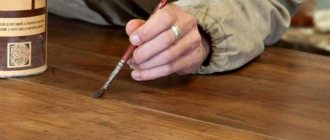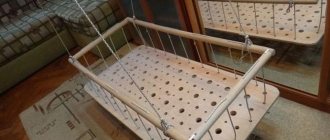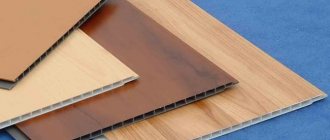If you decide to use different types of handles on cabinets and drawers, we advise you to keep all the fittings in the same style. You can buy pens from the same collection or look for similar ones in color and texture.
Photo: inspirabytes.com
It is better to choose accessories from durable material, such as metal or wood. Plastic handles are more fragile and break more often than others. Another disadvantage of plastic is that it deforms from high temperatures. The kitchen is often hot, and this can lead to negative consequences.
Calculate the exact cost of repairs using an online calculator
and receive a free detailed estimate for repairs
Calculate
When choosing in a store, consider the proportions of furniture and handles. The length of the handle should be one third of the length of the drawer. You can attach multiple handles to very long drawers. Small fittings will not fit furniture that is difficult to open or drawers in which you plan to store something heavy. Try to see if the handle is comfortable for you to hold and if its size suits your hand.
Some handles have complex attachments, so double-check before installing that you can comfortably open the drawers at that height. After installation, pull the box towards you using the handle. If you manage to do this with one little finger, you can rest assured that you have chosen the right pen.
Handles for kitchen facades: selection criteria
Decorative handles for furniture perform both aesthetic and practical functions. The design of these elements emphasizes the style and overall appearance of the kitchen set and gives the interior integrity and completeness. In addition, handles for kitchen facades should be easy to use, durable and securely fastened to the surface, because the doors of most kitchen cabinets and cabinets are used intensively.
Oblong silver handles look perfect on kitchen furniture
Handles on kitchen facades of ready-made units are installed or supplied by the manufacturer, but when making a kitchen according to an individual drawing, you will have to choose the fittings yourself. The appearance of this element can completely transform the design of the kitchen, so replacing handles is often done in the process of updating a boring interior.
Design and shape of handles for integrated and conventional kitchen fronts
Manufacturers of furniture fittings offer a huge range of products of this type. There are thousands of products on the market that differ in design, material of manufacture, shape and method of fastening. To understand all the variety and choose beautiful, durable and functional handles for your kitchen set, you should first familiarize yourself with the main varieties and features of this type of furniture.
Kitchen handles are made from the following materials:
- Alloys of various metals. An alloy of zinc and aluminum is often used, which allows the product to be given the most intricate shape while maintaining high strength. Bronze, copper, brass and other materials are used to make expensive products. The surface coating can be matte, shiny, gold or silver, or patinated. Plastic. Inexpensive material that does not have high strength and durability characteristics.
- Wooden handles for furniture. A natural, visually pleasing material that has all the necessary performance characteristics and harmonizes with wooden facades.
- Ceramic handles for furniture. They look original, but products made from quality materials are relatively expensive.
- Glass. Edges that refract light can give the kitchen an interesting look.
- A combination of different materials (metal with wood, ceramic or plastic inserts, wood with glass and other options).
Galvanic coating, used by serious manufacturers, significantly extends the service life of metal handles and protects the surface from scratches and abrasions. When purchasing, you should ask the seller if such processing is available.
Copper handles with patterns are well suited for walnut furniture.
Depending on the shape, furniture handles are divided into the following types:
- In the shape of a ring. They are made of metal, in harmony with wooden facades.
- Drop-shaped. A classic, inexpensive option, often used with plastic facades. From a practicality point of view, it is not the most convenient option, since the streamlined “drop” easily slips out of wet fingers.
- Sinks. The shape follows the downward-facing shell of the shell.
- Buttons. Compact products are made from all available materials, which allows you to choose the right option for any facade.
- Staples. The most practical and common option, providing a comfortable grip. Produced mainly from metal alloys.
- Railing handles for the kitchen are a smooth or matte tube of various sections, mounted on two supports. The distance between supports ranges from 96 to 800 mm. Ideal for interiors designed in modern or high-tech style.
You can ensure convenient and comfortable opening of doors not only with the help of furniture handles. Push- to- system allows you to open or close the door with a light press; in other models, milling is used to create grooves - such recesses are not inferior in functionality to handles, and the facade remains smooth, without protruding elements.
Manufacturing materials
The most durable and functional handle is made of stainless steel . Wood and ceramics are inferior to metal in these indicators. Nevertheless, it is these materials that create the unique comfort and coziness inherent in classic styles.
handles made of transparent plastic, acrylic or with crystal inserts in the kitchen. They are not cheap and very impractical: acrylic and transparent plastic are susceptible to scratches, and glass or crystal inserts tend to fall out.
Most modern metal handles from major manufacturers have a high-quality wear-resistant coating applied by electroplating. It is not afraid of mechanical damage, resistant to corrosion and abrasion. Beware of cheap fakes, the paint layer of which will peel off after a few months.
Rules for selecting profile options, McMart, invisible built-in models
When choosing handles for kitchen facades, you should pay attention to the following points:
- Material of manufacture. Kitchen fittings must have increased strength, resistance to abrasion and temperature changes, moisture resistance and durability. Such characteristics are fully inherent in products made of metal and wood.
- Design. Kitchen handles should be in harmony not only with the furniture set, but also with other furnishings.
- Mounting method. Kitchen furniture handles, which have one attachment point, can turn and become loose during use, gradually widening the mounting hole. Fastening at two points is more practical; in this case, the handles for kitchen cabinets are securely fixed in one position.
- Ease of use. The shape should be easy to grip both from above and below (or from the right and left for vertically positioned products) and not slip out of wet or greasy fingers. The surface should be easy to clean, since in the kitchen you often have to open doors with dirty hands.
Classic silver handles look perfect with the lilac tone of the kitchen
Tips for choosing
When ordering a custom-made set, the designer will tell you which handles are best to choose for the kitchen and offer several optimal options. Try to take into account expert recommendations - they are aimed at selecting not only furniture that harmoniously matches the aesthetics, but also fittings that are easy to use.
The choice of handles should be made based on the following recommendations:
- level of comfort – the fittings should fit comfortably in the hand, because you will have to use them every day;
- ease of grip - it is desirable that the palm of your hand fits into the “brackets” or rails, and not 1-2 fingers;
- safety – you should refrain from choosing models with sharp corners and elements that protrude excessively from the geometry of the overall design;
- identity - the location of handles on kitchen facades requires a harmonious combination of fittings in design, geometry, shade and decor;
- proportionality - the dimensions of the fittings must correspond to the size of the door or drawer, and should not be too large in relation to the design of the furniture;
- size – if the modules are identical, you can use kitchen door handles of the same size, but when combining large and small blocks in a set, it is better to choose fittings of 2-3 sizes;
- visual effect - if the arrangement of handles in the kitchen requires their installation on upper cabinets, then massive fittings will not be suitable for this purpose; you should give preference to more compact, mortise or touch models;
- compatibility - the shade and decor of the material of the handles must match the aesthetics of the metal of other elements of the set.
The proportionality of the modules and fittings comes to the fore: the shorter the façade, the smaller the handle size should be. So, for a door 60 cm wide, it is worth using rails with a center-to-center distance of about 420-236 mm, but for small drawers 200-300 mm wide, models with a distance between fasteners of no more than 90-96 mm are ideal.
Particular attention should be paid to modules that will be located in close proximity to the wall. Here it is important to use handles for kitchen furniture that will not protrude beyond the facades and will not damage the wallpaper when opened and closed regularly. Here it is important to understand whether to place handles in the kitchen vertically or horizontally - usually the best option is the vertical placement of small fittings.
Choosing kitchen handles depending on design style
When choosing furniture handles, it is important to ensure that they match the design style of the set. Otherwise, they will not only look different from other metal elements, but will also bring chaos to the aesthetic concept. Let's note the fittings options for the most popular design trends:
- loft – brackets, rails, mortise models;
- classics - forged staples or models with ornaments, buttons and “earrings”;
- vintage – button handles, carved staples;
- high-tech – touch-sensitive models, backlit handles, roof rails and brackets;
- modern - brackets, rails, profile handles.
Try to be guided by the principle of combining shades of elements made from identical materials. So all the metal in the fittings should have not only a similar color, but also the same texture. If an “antique effect” is used, then it must be identical on all products.
Self-installation: does size matter for horizontal and vertical installation?
To install kitchen handles on your own, you will need a set of tools that every skilled owner has: a drill with a drill of the required diameter, a screwdriver, a tape measure and a pencil. Installation is performed as follows:
- The placement height is determined and markings are made. The choice of height should be approached from the point of view of convenience for all family members and taking into account the height of each person living. Opening the door of a hanging cabinet should not require the use of a stand, and the door of a cabinet should not require squatting or bending too low. If the door has a panel installed, markings for the holes are made on the side frame.
- Having determined the optimal height, a template is made from cardboard so as not to make the same measurements for each individual door. It is worth paying attention to the symmetrical arrangement of products on drawers.
- Installation is carried out on unattached doors placed on a flat surface. Two wooden blocks of equal height are placed under the façade.
- Holes are drilled according to the markings.
- An overhead washer is installed on the reverse side and a mounting bolt is screwed in.
How to place handles on kitchen cabinet drawers?
It depends on what kind of pens and what sizes they are.
“Classic” is an option with the same distance from the bottom of the drawer (more precisely, a drawer in a cabinet) to the top and the same distance from the edge of the handle to the edge of the drawer.
It's like in the photo.
This location has a number of advantages.
There is a “centering” of the handle, the drawer can be pulled out conveniently, without excessive effort.
Small oval handles are also attached in the same way (also, this is in the center).
There are handles for the entire width of the drawer, in this case also in the center, but only the bottom and top.
If the cabinet drawer does not slide out, but opens from top to bottom, then it is better to attach the handle higher to the top of the drawer, this will make it easier to open it.
The handle option closer to the top of drawers is also acceptable, here is a photo of this arrangement of handles.
Here the configuration of the handles and the mechanism for opening the cabinets allows this to be done.
In general, it’s better (personal opinion) to leave the factory “settings” in place; if the handles are moved to another place, then what to do with the holes for the old place where the handles were attached.
The traditional location of handles on cabinets (facades) of floor-standing kitchen cabinets is strictly in the middle . However, I believe that we need to think outside the box .
Installation
It is better to entrust the installation of accessories to professionals . But if you are confident in your abilities and are “friendly” with the tool, you can do the installation of ordinary furniture handles yourself. First, decide on the location of the handles on the kitchen facades.
It's not difficult if you know a few simple rules:
- Handles on drawers are installed horizontally. Placement horizontally - in the center, vertically - in the center or at a distance of 35 mm from the top edge of the box.
- On the doors of the upper tier with left- or right-hand opening, the handles are installed vertically. Placement of the lower support of the handle (for buttons - center) horizontally - 35-40 mm from the edge of the sash, vertically - 35-40 mm from the lower edge of the sash.
- On upper tier sashes with lifting mechanisms, handles are installed horizontally. Placement horizontally - in the center, vertically - at a distance of 35 mm from the bottom edge of the sash.
How to screw handles to facades ? 4-5 mm holes are drilled in the designated places (depending on the fastening of the handles). Fastening is done using screws and washers.
Handles for the kitchen - details about the details
High-quality fittings for kitchen furniture should be selected very carefully. This is especially true for such an element as handles - after all, they have both functional and decorative purposes. Indeed, it is impossible to imagine a kitchen set without handles. But your kitchen will only be original, attractive and easy to use if you select all its elements correctly.
Main types of kitchen handles
Furniture handles can be made of colored plastic or decorated with rhinestones. Naturally, before purchasing, you will have to analyze many factors - from the color of the room and the style of furniture to financial possibilities, but the main thing you will have to figure out is what kind of handles there are.
As a rule, fittings offered by trusted manufacturers can be of the following types and forms:
- The ring handles mounted on a decorative base are massive, noble and elegant. The material for their manufacture is metal, patinated or coated with bronze plating. They go perfectly with classic wooden kitchen fronts. However, each time the doors will need to be opened very carefully so as not to damage the facades;
Selecting pens based on technical specifications
It's no secret that kitchen doors are opened many times every day. Therefore, you need to choose handles for the headset so that they are not only a decorative element, but also provide proper functionality.
For this reason, metal or wood fittings are most often chosen rather than plastic fittings. Plastic, especially cheap plastic, cannot provide the necessary durability and practicality. In addition, it can even become deformed due to high temperatures. However, there is also a risk of damage to wooden handles - therefore they are not placed in the area of high temperatures. As for metal, this will be the ideal choice for all cases.
Tip: It is very important to choose the right size of handles. Small products fastened with one screw are considered the most impractical. That's why staples have gained popularity, coming in a variety of styles and in a wide size range. From an ergonomic point of view, a large handle will always be more comfortable than a small one. In addition, they are attached to the facade in several places, which guarantees increased reliability.
CLASSIFICATION OF FURNITURE HANDLES
So, the most common classification of furniture handles is as follows:
HANDLE-BRACKET
The most popular and traditional type of furniture handles. In appearance, the handle-brackets resemble a semicircular or U-shaped bracket, hence their name. Attachment to the surface most often occurs at two points. The style variety of staples includes smooth rounded shapes, regular geometric lines, unusual forged or carved elements, ceramic inserts, and crystals. In any case, regardless of aesthetic modifications, the handle-bracket is very practical and reliable in use. That is why handles-brackets decorate a huge number of furniture sets of various styles.
The main advantages of handle brackets include:
- Comfort and ergonomics:
the staples seem to be designed to fit perfectly in the palm of your hand - Versatility:
thanks to the variety of styles and sizes, it’s easy to choose the perfect set for any furniture - Reliability:
due to fastening on both sides with 2 screws, they not only serve as a decorative element, but also carry a serious functional load - Durability:
the handles will definitely serve you for many years without requiring special care. Elegant thin products, ceramic and glass inserts will require a little more care.
HANDLES-BUTTONS
In terms of popularity of use, buttons easily compete with handle-brackets. This type of handle is a cap on a stem. As a rule, miniature products that are attached to furniture with a single screw. Most often, such handles are used on the fronts of drawers, cabinets and chests of drawers.
The main advantages of knob-buttons:
- A variety of shapes:
pens of this type are round, square, triangular and polygonal; designers also create them in the form of various figures - animals, plants, symbols - Simple installation:
easy to install and dismantle in case of replacing handles (for example, it is more difficult to change handle-brackets, since the new handle must be the same size, otherwise previous manipulations will be noticeable on the facade) - Compatibility:
buttons often come complete with brackets, so it’s easy to decorate the interior in the same style, while placing the necessary accents
HANGING HANDLES-RINGS AND DROPS
Original representatives of fittings that are attached to a decorative base. The hanging part can be made in the form of a ring or an elongated part that expands downwards - a drop. As a rule, this type of furniture handles cannot be called fully functional; rather, they are an original decoration for furniture.
The advantages of this type of handles include:
- Originality:
even if the handles look simple, they cannot be ignored. The unique appearance does not prevent the handles from harmoniously complementing almost any interior - Design:
on the one hand, this is an advantage, since hanging products will add elegance and originality to the furniture set. On the other hand, such pens must be handled carefully so as not to accidentally tear off a ring or a drop. You should also carefully pull out the drawers, as the moving element can damage the façade over time.
HANDLES-RAILINGS
They are a cylindrical crossbar with two fixing legs. Handle rails can be installed both horizontally and vertically, it all depends on your own preferences and the ergonomics of the furniture set.
The advantages of handle rails include:
- Reliability:
most often, handle rails are heavier than traditional handle handles, making them suitable for more massive facades, and sometimes have a special protective coating - Ergonomic and practical:
roof rails are extremely convenient to use - Stylish design:
thanks to the laconic design of such fittings, it will adequately decorate furniture, especially in a modern style - Wide range of sizes:
these handles can be combined with furniture sets of various sizes. In addition, vertically oriented handles are a godsend for a family where both large and small people use furniture: the height of the handle does not need to be adjusted to suit everyone.
END HANDLES
They are installed on the end of the door leaf, without loading the furniture facade with additional parts. They are an excellent alternative to painted facades with integrated handles, because such facades often have a high cost.
Depending on the installation method, handle profiles are divided into:
→ Mortise - the furniture end is pre-milled and installed in a groove at the end of the facade
→ Overhead – the handle is attached to the inside of the facade using self-tapping screws, which facilitates installation and does not require any additional manipulations with the facade
And now about the advantages of end handles:
- Wide range of sizes:
there is a perfect handle for any door length - Minimalism:
thanks to their “invisibility”, profile handles practically merge with the facade and keep the facades clean - Reliability:
integrated into the furniture fabric, the profile practically does not wear out - Functionality:
such handles are used in kitchens, dressing rooms, bathrooms, hallways, as well as in any minimalist style rooms
MORTASE HANDLES
Mortise handles are a special type of furniture handles with a more complex installation: installation of such handles requires preliminary milling of the surface, the shape and dimensions of which completely depend on the model of the mortise handle. After inserting the handle into the prepared groove and then securing it with screws, the handle almost completely merges with the plane of the facade.
An ideal solution for wardrobes and sliding doors where any protruding parts of the fittings need to be minimized.
Advantages of mortise handles:
- Design:
allows mortise handles to be almost invisible, not protrude above the surface and become one with the furniture. Mortise solutions are used where conventional handles can become an obstacle to opening adjacent cabinets or sections - Versatility:
suitable for many pieces of furniture (cabinets, cabinets, etc.) - Functionality:
equally easy to use on both a hinged door and a drawer
SINK HANDLES
Overhead handles shaped like shells. They have an ergonomic shape, as if they were created for the fingers. Despite the fact that sink handles are not as widely popular as handles or buttons, they can add uniqueness to any furniture, and will look especially impressive on kitchen sets in a classic style.
The obvious advantages of sink handles include:
- Ergonomics:
the fairly simple shape of the handles is comfortable to grip and allows you to open drawers and doors on furniture without any extra effort - Minimal maintenance:
the design of the furniture handle allows you to touch your hands only from the inside, which allows the outer surface of the handle to always remain clean - Versatility:
thanks to its simple and laconic shapes, sink handles will harmoniously complement many pieces of furniture in the living room, office, kitchen or bedroom
Fittings that match the style - what is it?
The fittings must be reliable, practical and highly decorative. You can’t choose these particular handles with rhinestones just because they made an impression on the exhibition stand - you need to thoughtfully evaluate the overall style of the kitchen and choose the appropriate solution. There are not many basic recommendations here:
- For furniture in a classic style, bronze or porcelain handles are suitable.
- Are you looking for an option for a high-tech kitchen set? You cannot do without modern railings - these are original brackets, straight, laconic and very comfortable. Railings are installed on plastic or aluminum facades, and they can be mounted both vertically and horizontally.
- Bracket handles are also simple in shape and are suitable for horizontal or vertical placement. As a rule, such options are not overloaded with carvings or rhinestones, and therefore are ideal for “modern classics” and modernity. The most common colors in which staples are produced are wood, bronze, aluminum, chrome, satin, and gold.
- For kitchens in Provence or vintage style, artificially aged fittings or classic handles with porcelain inserts, looking like aristocratic antiques, are chosen.
- Unique handles with Swarovski crystals will become a masterpiece for a unique brilliant interior. By the way, kitchen facades can also be decorated with rhinestones. However, you shouldn’t “strew the whole kitchen with diamonds” - it will be enough if only the handles are decorated with rhinestones. By the way, they go well with laconic painted surfaces.
Popular models
Kitchen furniture handles come in a wide variety of models, differing in design, style, size and functionality. The range of manufacturers includes hundreds of variations of shapes, sizes and concepts - from classic “staples” to non-trivial handles in the form of cutlery.
TOP 5 most popular handles for kitchen sets:
- Handles-brackets. The fittings have a U-shaped or curved design and are attached to the facade with two screws. The center-to-center distance varies in the range of 16-480 mm. These are comfortable and not too expensive pens that have become the most popular on the market.
- Railing. They are a crossbar in the shape of a plank or a cylinder, which is attached to the facade using two brackets. The design may include protruding or aligned crossbar holders. These are fashionable handles for the kitchen, which are especially in demand for sets in the Art Nouveau, high-tech and neoclassical styles.
- Handles-buttons. The shape of the upper part of the fittings can be a circle, oval, square or rectangle, the design can be flat or convex, the height of the leg is usually small, and there is only one fastening element. Such kitchen handles look best on the facades of sets made in Provence, vintage, classic and country styles.
- Profile handles. The design is a hollow profile made of aluminum or plastic. Fastening is carried out on the upper or side section of the door. These are original versions of kitchen handles, which are not so often found in domestically produced sets and are most suitable for interiors in the modern or high-tech style.
- Sinks. They are a variation of handles with a stylized upper part like a clam shell. Such fittings have a specific aesthetic and are suitable for vintage and classic interiors.
An alternative to handles protruding above the surface of the facade can be mortise or touch models. Built-in solutions blend completely with the front of the door or drawer and are easy to use, but rather complex to install.
Another technological solution is touchscreen models, which are often equipped with LED backlighting. These types of pens are made of special plastic and run on batteries. When you lightly touch them, the door opens or closes. If the backlight is installed, a soft glow accompanies the operation of the mechanism and goes out within 15-30 seconds.











